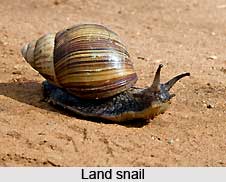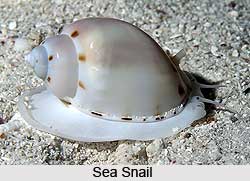 Types of Snail include the land snail, sea snail, river snail, etc. Snails possess a distinct head and a pair of tentacles which retreat and extend. The eyes of the snails are located at the basal portion of the tentacles. Snails bear mouths having a row of teeth which are replaced once they wear down and they also possess a tongue known as radula. A majority of the snails feed on dead animals and plant. The Snails bear muscular foot having slime glands which help them while they move slowly on their foot. One of the common types of Snail is the Land snail.
Types of Snail include the land snail, sea snail, river snail, etc. Snails possess a distinct head and a pair of tentacles which retreat and extend. The eyes of the snails are located at the basal portion of the tentacles. Snails bear mouths having a row of teeth which are replaced once they wear down and they also possess a tongue known as radula. A majority of the snails feed on dead animals and plant. The Snails bear muscular foot having slime glands which help them while they move slowly on their foot. One of the common types of Snail is the Land snail.
Land Snails are very familiar among the different varieties of Snails. They are identified by the slime-coated, trailing body which comes out of a roundish spiral shell. The animal moves with such a slow pace that in English `a snail`s pace` means very slow indeed. A snail has two pairs of tentacles on its head: a short pair in front and a long pair a little behind. The hinder pair has an eye at the tip of each tentacle. Snails can contract and completely withdraw these tentacles into a hollow in the head. Land Snails are vegetarians (plant-eating). Their mouth is a simple aperture below the head armed with an arched jaw which helps to grip the tender shoots. For grinding the vegetable matter they have a broad radula with rows of uniform squarish teeth. In length this radula does not exceed thrice its breadth. Their habits are particularly interesting. As a rule they are moisture-loving animals. In rainy months except when there are heavy downpours, they are found in large numbers moving about over moist stones, moss-covered walls and plants of various kinds. During the hot dry season they close the lid of their shells tight and remain inactive, buried in loose earth or concealed under thick debris.
 Sea Snails are of different kinds and they vary widely in shape, habits and other details. There are the Top and Turban Shells, Periwinkles and Violet snails. Top shells and Turban shells are familiar univalve molluscs of all seashores, living on mud-covered rocks of the intertidal region. In their internal structural details they agree with the primitive gastropods like Limpets. They possess a radula, carrying numerous tiny teeth for grinding sea plants. Their shells are fairly heavy, usually brightly coloured, ornamented outside and pearly within. Periwinkles are represented abundantly on all the rocky shores of India by the genus Littorina and the allied Planaxis. They are a group of interesting sea snails. Another interesting sea snail of pelagic habit is the Sea Butterfly - Cavolina belonging to the group Pteropoda. It is an extremely interesting mollusc in that its structure and habits amply justify the name `sea butterfly` given to it. Its shell is not coiled but straight and usually elongated and its foot modified into a pair of wing-like fins, arranged one on either side of the mouth, enabling it to swim with ease.
Sea Snails are of different kinds and they vary widely in shape, habits and other details. There are the Top and Turban Shells, Periwinkles and Violet snails. Top shells and Turban shells are familiar univalve molluscs of all seashores, living on mud-covered rocks of the intertidal region. In their internal structural details they agree with the primitive gastropods like Limpets. They possess a radula, carrying numerous tiny teeth for grinding sea plants. Their shells are fairly heavy, usually brightly coloured, ornamented outside and pearly within. Periwinkles are represented abundantly on all the rocky shores of India by the genus Littorina and the allied Planaxis. They are a group of interesting sea snails. Another interesting sea snail of pelagic habit is the Sea Butterfly - Cavolina belonging to the group Pteropoda. It is an extremely interesting mollusc in that its structure and habits amply justify the name `sea butterfly` given to it. Its shell is not coiled but straight and usually elongated and its foot modified into a pair of wing-like fins, arranged one on either side of the mouth, enabling it to swim with ease.
Two other common genera of freshwater snails are the Viviparus and the Pila. Both have similar habits and habitat. In Viviparus the shell is thin, covered by an olive-green protective coating and coiled like a turban. As its very name implies, this snail is viviparous - the young develop within the parent and are born as miniature adults. Viviparus is purely gill-breathing and remains in water. Pila is the common Apple-snail, mush larger than Viviparus, with a thicker and globular shell having a low spire. It is found in plenty in all ponds and water-clogged paddy fields. It has both a lung and a gill and can live in and out of water. It also possesses a fleshy siphon or tube by which it can suck air into the lung while actually under water. When, due to rains and floods, the pond waters get mixed with slime, mud and other debris, clogging the gills, this mollusc can come up periodically to the surface and suck air through the tube. During summer, when the ponds and fields are dried up, Pila withdraws into its shell, tightly closes it up with its lid and estivates embedded in mud until the return of favourable conditions. It lays its eggs in large clusters on the stems of water-plants under the surface.



















